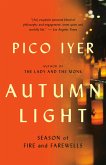"Arguably the greatest living travel writer" (Outside magazine), Pico Iyer has called Japan home for more than three decades. But, as he is the first to admit, the country remains an enigma even to its long-term residents. In A Beginner's Guide to Japan, Iyer draws on his years of experience-his travels, conversations, readings, and reflections-to craft a playful and profound book of surprising, brief, incisive glimpses into Japanese culture. He recounts his adventures and observations as he travels from a meditation hall to a love hotel, from West Point to Kyoto Station, and from dinner with Meryl Streep to an ill-fated call to the Apple service center in a series of provocations guaranteed to pique the interest and curiosity of those who don't know Japan-and to remind those who do of its myriad fascinations.
Impishly provocative … Rarely in any writing on Japan is provocation so elegantly and surgically performed … Japan and the Japanese have long seemed to lend themselves addictively to interpretation by outsiders. By inviting all types of readers to see the flaws in that tendency from the outset, Iyer neatly sheds the burden of being right about everything while crafting a framework within which to enjoy the place








